Mining-Related Metal Pollution and Ecological Risk Factors in South-Eastern Georgia
Abstract
:1. Introduction
2. Materials and Methods
2.1. Description of Study Area
2.2. Sampling and Analytical Methods
2.3. Statistical Analyses
3. Results and Discussions
3.1. Soil Chemistry
3.2. Water Chemistry
4. Conclusions
Author Contributions
Funding
Institutional Review Board Statement
Informed Consent Statement
Data Availability Statement
Acknowledgments
Conflicts of Interest
References
- Salomons, W. Environmental impact of metals derived from mining activities: Processes, predictions, prevention. J. Geochem. Explor. 1995, 52, 5. [Google Scholar] [CrossRef]
- Cooke, J.A.; Johnson, M.S. Ecological restoration of land with particular reference to the mining of metals and industrial minerals: A review of theory and practice. Environ. Rev. 2002, 10, 41. [Google Scholar] [CrossRef] [Green Version]
- Li, Z.; Ma, Z.; Van Der Kuijp, T.J.; Yuan, Z.; Huang, L. A review of soil heavy metal pollution from mines in China: Pollution and health risk assessment. Sci. Total Environ. 2014, 468, 843–853. [Google Scholar] [CrossRef] [PubMed]
- Li, T.; Li, Y.; An, D.; Han, Y.; Xu, S.; Lu, Z.; Crittenden, J. Mining of the association rules between industrialization level and air quality to inform high-quality development in China. J. Environ. Manag. 2019, 246, 564. [Google Scholar] [CrossRef]
- Abdul-Wahab, S.; Marikar, F. The environmental impact of gold mines: Pollution by heavy metals. Open Eng. 2012, 2, 304. [Google Scholar] [CrossRef]
- Korça, B.; Demaku, S. Evaluating the presence of heavy metals in the vicinity of an industrial complex. Pol. J. Environ. Stud. 2020, 29, 3643. [Google Scholar] [CrossRef]
- Linhua, S.; Songbao, F. Heavy Metals in the Surface Soil around a Coalmine: Pollution Assessment and Source Identification. Pol. J. Environ. Stud. 2019, 28, 2717. [Google Scholar] [CrossRef]
- Felix-Henningsen, P.; Urushadze, T.F.; Narimanidze, E.I.; Wichmann, L.; Steffens, D.; Kalandadze, B.B. Heavy Metal Pollution of Soils and Food Crops due to Mining Wastes in the Mashavera River Valley. Bull. Georg. Natl. Acad. Sci. 2007, 175, 35–49. [Google Scholar]
- Gongadze, A.; Matchavariani, L.; Avkopashvili, M.; Avkopashvili, G. Accumulation and distribution of heavy metals in soils from the explosions by mining-processing poly-metallic plant. Int. Multidiscip. Sci. GeoConference SGEM 2018, 18, 11–18. [Google Scholar]
- Avkopashvili, M.; Gongadze, A.; Avkopashvili, G.; Matchavariani, L.; Asanidze, L.; Lagidze, L. Metals distribution in soil contaminated by gold and copper mining in Georgia. J. Environ. Biol. 2020, 41, 310. [Google Scholar] [CrossRef]
- Little, C.; Magalashvili, A.; Banks, D. Neotethyan Late Cretaceous volcanic arc hydrothermal vent fauna. Geology 2007, 35, 835. [Google Scholar] [CrossRef]
- Magalashvili, A. New factors of the Bolnisi mining district economic geology (Southern Georgia). Proc. Georgian Acad. Sci. Geol. Inst. New Ser. 2004, 119, 823. [Google Scholar]
- Hanauer, T.; Felix-Henningsen, P.; Steffens, D.; Kalandadze, B.; Navrozashvili, L.; Urushadze, T. In situ stabilization of metals (Cu, Cd, and Zn) in contaminated soils in the region of Bolnisi, Georgia. Plant Soil 2011, 341, 193. [Google Scholar] [CrossRef]
- Avkopashvili, G.; Avkopashvili, M.; Gongadze, A.; Gakhokidze, R. Eco-monitoring of Georgia’s contaminated soil and water with heavy metals. Carpathian J. Earth Environ. Sci. 2017, 12, 595. [Google Scholar]
- Felix-Henningsen, P.; Urushadze, T.; Steffens, D.; Kalandadze, B.; Narimanidze, E. Uptake of heavy metals by food crops from highly-polluted Chernozem-like soils in an irrigation district south of Tbilisi, eastern Georgia. Agron. Res. 2010, 8, 781. [Google Scholar]
- Matchavariani, L.; Kalandadze, B. Pollution of soils by heavy metals from irrigation near mining region of Georgia. Forum Geogr. 2012, 11, 127–136. [Google Scholar] [CrossRef]
- Withanachchi, S.S.; Ghambashidze, G.; Kunchulia, I.; Urushadze, T.; Ploeger, A. Water quality in surface water: A preliminary assessment of heavy metal contamination of the Mashavera River, Georgia. Int. J. Environ. Res. Public Health 2008, 15, 621. [Google Scholar] [CrossRef] [Green Version]
- Hakanson, L. An ecological risk index for aquatic pollution control a sedimentological approach. Water Res. 1980, 14, 975. [Google Scholar] [CrossRef]
- Mugoša, B.; Đurović, D.; Nedović-Vuković, M.; Barjaktarović-Labović, S.; Vrvić, M. Assessment of Ecological Risk of Heavy Metal Contamination in Coastal Municipalities of Montenegro. Int. J. Environ. Res. Public Health 2016, 13, 393. [Google Scholar] [CrossRef] [Green Version]
- Sherameti, I.; Varma, A. Heavy metal contamination of soils: Monitoring and remediation. In Soil Biology; Springer: Cham, Switzerland, 2015; Volume 44. [Google Scholar]
- Wu, J.; Jia, R.; Xuan, H.; Zhang, D.; Zhang, G.; Xiao, Y. Priority Soil Pollution Management of Contaminated Site Based on Human Health Risk Assessment: A Case Study in Southwest China. Sustainability 2022, 14, 3663. [Google Scholar] [CrossRef]
- Latif, A.; Bilal, M.; Asghar, W.; Azeem, M.; Ahmad, M.I.; Abbas, A.; Ahmad, M.Z.; Shahzad, T. Heavy metal accumulation in vegetables and assessment of their potential health Risk. J. Environ. Anal. Chem. 2018, 5, 234. [Google Scholar] [CrossRef]
- Guo, B.; Su, Y.; Pei, L.; Wang, X.; Wei, X.; Zhang, B.; Zhang, D.; Wang, X. Contamination, Distribution and Health Risk Assessment of Risk Elements in Topsoil for Amusement Parks in Xi’an, China. Pol. J. Environ. Stud. 2021, 30, 601. [Google Scholar] [CrossRef]
- Rolka, E.; Żołnowski, A.C.; Sadowska, M.M. Assessment of heavy metal content in soils adjacent to the DK16-Route in Olsztyn (North-Eastern Poland). Pol. J. Environ. Stud. 2020, 29, 4303. [Google Scholar] [CrossRef]
- Bartkowiak, A.; Piątek, M. Analysis of heavy metal content in soil fertilised with fresh and granulated digestate. Pol. J. Environ. Stud. 2020, 29, 3517. [Google Scholar] [CrossRef]
- Hassan, N.U.; Mahmood, Q.; Waseem, A.; Irshad, M.; Pervez, A. Assessment of heavy metals in wheat plants irrigated with contaminated wastewater. Pol. J. Environ. Stud. 2013, 22, 115. [Google Scholar]
- Jaishankar, M.; Tseten, T.; Anbalagan, N.; Mathew, B.B.; Beeregowda, K.N. Toxicity, mechanism and health effects of some heavy metals. Interdiscip. Toxicol. 2014, 7, 60. [Google Scholar] [CrossRef] [Green Version]
- Wongsasuluk, P.; Chotpantarat, S.; Siriwong, W.; Robson, M. Heavy metal contamination and human health risk assessment in drinking water from shallow groundwater wells in an agricultural area in Ubon Ratchathani province, Thailand. Environ. Geochem. Health 2014, 36, 169. [Google Scholar] [CrossRef]
- Zhang, F.; He, Y.; Zhao, C.; Kou, Y.; Huang, K. Heavy Metals Pollution Characteristics and Health Risk Assessment of Farmland Soils and Agricultural Products in a Mining Area of Henan Province, China. Pol. J. Environ. Stud. 2020, 29, 3929. [Google Scholar] [CrossRef]
- Obiora, S.C.; Chukwu, A.; Toteu, S.F.; Davies, T.C. Assessment of Heavy Metal Contamination in Soils Around Lead (Pb)-Zinc (Zn) Mining Areas in Enyigba, Southeastern Nigeria. J. Geol. Soc. India 2016, 87, 453. [Google Scholar] [CrossRef]
- Han, Z.X.; Wan, D.; Tian, H.X.; He, W.X.; Wang, Z.Q.; Liu, Q. Pollution Assessment of Heavy Metals in Soils and Plants around a Molybdenum Mine in Central China. Pol. J. Environ. Stud. 2019, 28, 123. [Google Scholar] [CrossRef]
- Hou, D.; O’connor, D.; Nathanail, P.; Tian, L.; Ma, Y. Integrated GIS and multivariate statistical analysis for regional scale assessment of heavy metal soil contamination: A critical review. Environ. Pollut. 2017, 231, 1188. [Google Scholar] [CrossRef] [PubMed]
- Luzio, M.D.; Sriniva, R.; Arnold, J.G. A GIS-Coupled Hydrological Model System for the Watershed Assessment of Agricultural Nonpoint and Point Sources of Pollution. Trans. GIS 2004, 8, 113. [Google Scholar] [CrossRef]
- Avkopashvili, G.; Avkopashvili, M.; Gongadze, A.; Tsulukidze, M.; Shengelia, E. Determination of Cu, Zn and Cd in soil, water, and food products in the vicinity of RMG gold and copper mine, Kazreti, Georgia. Ann. Agrar. Sci. 2017, 15, 269–272. [Google Scholar] [CrossRef]
- Kalandadze, B.; Matchavariani, L. Soil Pollution. In The Soils of Georgia; Springer: Cham, Switzerland, 2019; pp. 153–166. [Google Scholar]
- Omar, N.Y.M.J.; Abas, M.R.B.; Rahman, N.A.; Tahir, N.M.; Rushdi, A.I.; Simoneit, B.R.T. Levels and distributions of organic source tracers in air and roadside dust particles of Kuala Lumpur, Malaysia. Environ. Geol. 2007, 52, 1485. [Google Scholar] [CrossRef]
- Moustafa, M.; Mohamed, A.; Ahmed, A.R.; Nazmy, H. Mass size distributions of elemental aerosols in industrial area. J. Adv. Res. 2014, 6, 827. [Google Scholar] [CrossRef] [Green Version]
- Kubilay, N.; Nickovic, S.; Moulin, C.; Dulac, F. An illustration of the transport and deposition of mineral dust onto the eastern Mediterranean. Atmos. Environ. 2000, 34, 1293. [Google Scholar] [CrossRef]
- Mertens, J.; Lepaumier, H.; Rogiers, P.; Desagher, D.; Goossens, L.; Duterque, A.; Le Cadre, E.; Zarea, M.; Blondeau, J.; Webber, M. Fine and ultrafine particle number and size measurements from industrial combustion processes: Primary emissions field data. Atmos. Pollut. Res. 2020, 11, 803. [Google Scholar] [CrossRef]
- Chiroma, T.M.; Ebewele, R.O.; Hymore, F.K. Comparative assessment of heavy metal levels in soil, vegetables and urban grey wastewater used for irrigation in Yola and Kano. Int. Refereed J. Eng. Sci. 2014, 3, 1–9. [Google Scholar]
- Withanachchi, S.S.; Kunchulia, I.; Ghambashidze, G.; Al Sidawi, R.; Urushadze, T.; Ploeger, A. Farmers’ perception of water quality and risks in the Mashavera River Basin, Georgia: Analyzing the vulnerability of the social-ecological system through community perceptions. Sustainability 2018, 10, 3062. [Google Scholar] [CrossRef] [Green Version]
- Bakradze, E.; Shavliashvili, L.; Kuchava, G.; Bouachidze, N.; Shubladze, E. Heavy metal pollution of the river Kzretula by the Madneuli enterprise and restoration of its biodiversity. In Proceedings of the Geography: Development of Science and Education, Saint Petersburg, Russia, 21–23 April 2021; pp. 12–18. Available online: https://elibrary.ru/item.asp?id=46330348 (accessed on 21 March 2022).
- Buachidze, N.; Shavliashvili, L.; Bakradze, E.; Kuchava, G. Determination the water quality classification of the river Khrami and its tributaries. In Proceedings of the International Conference on Development of Applied Science and Humanities, Timisoara, Romania, 26–27 October 2021. [Google Scholar]
- Mchedluri, T.; Makharoblidze, N. Ecological Monitoring of the River Khrami Water and Anthropogenic Load. Russ. J. Biol. Res. 2018, 5, 20–26. [Google Scholar]

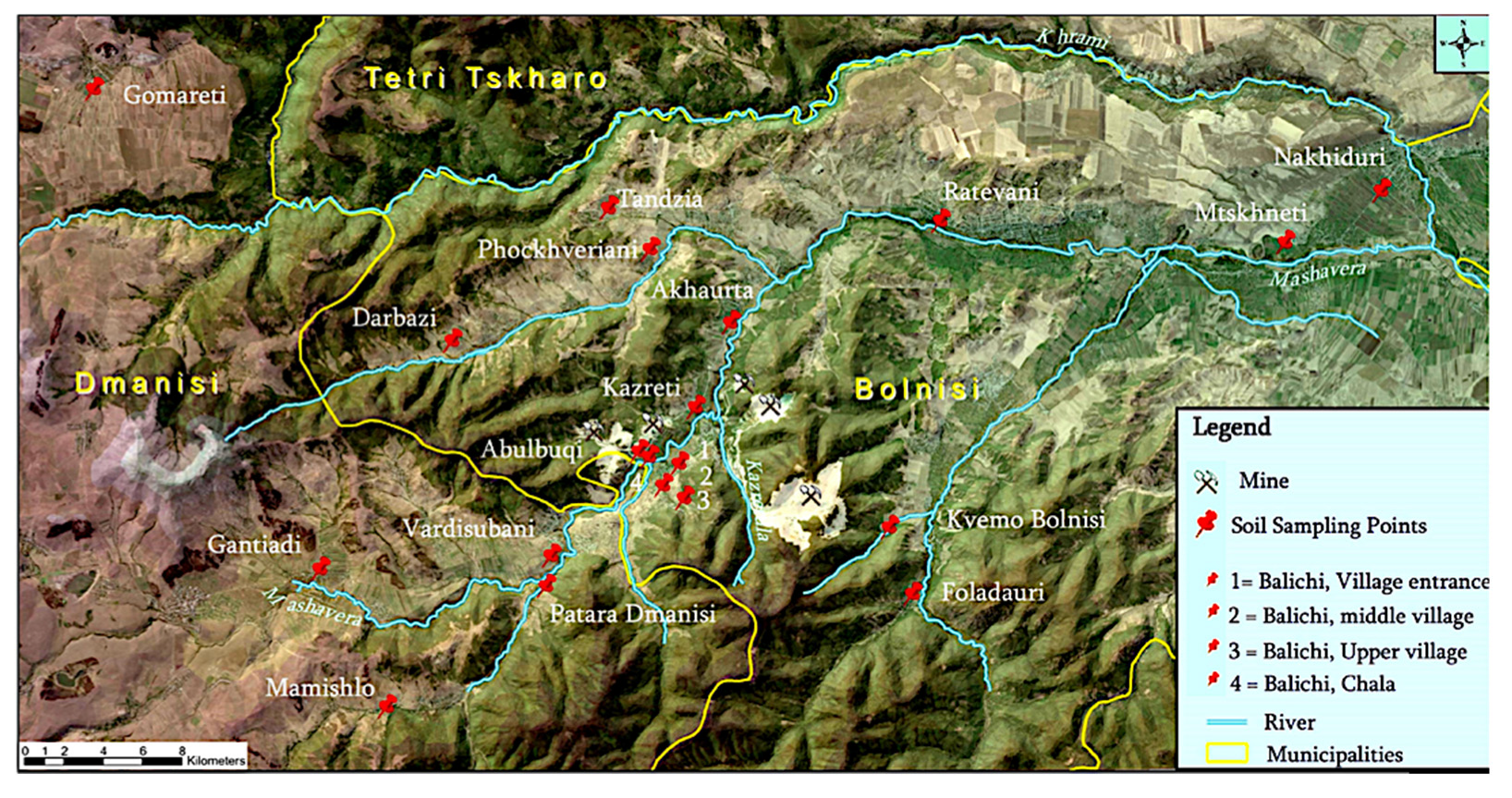

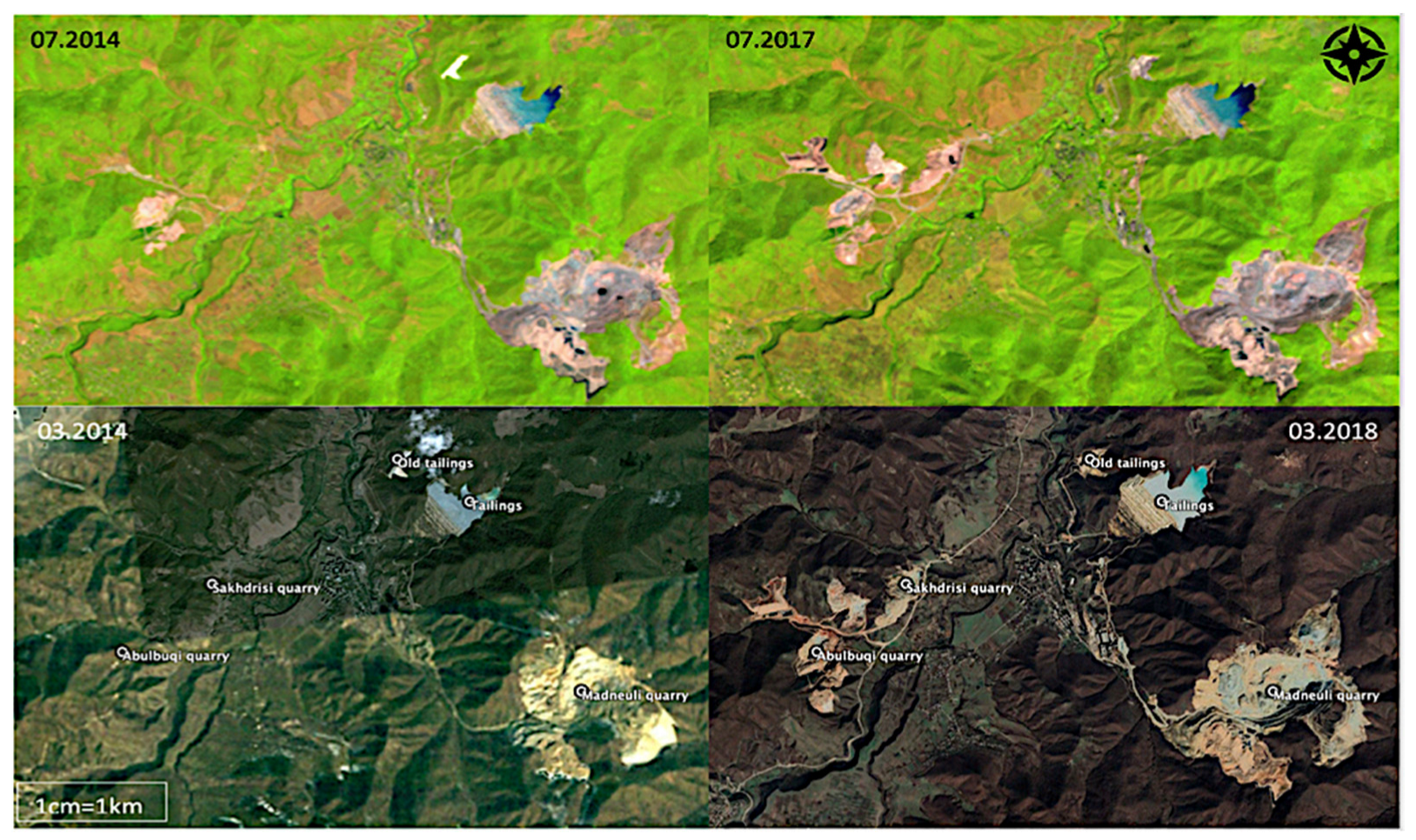
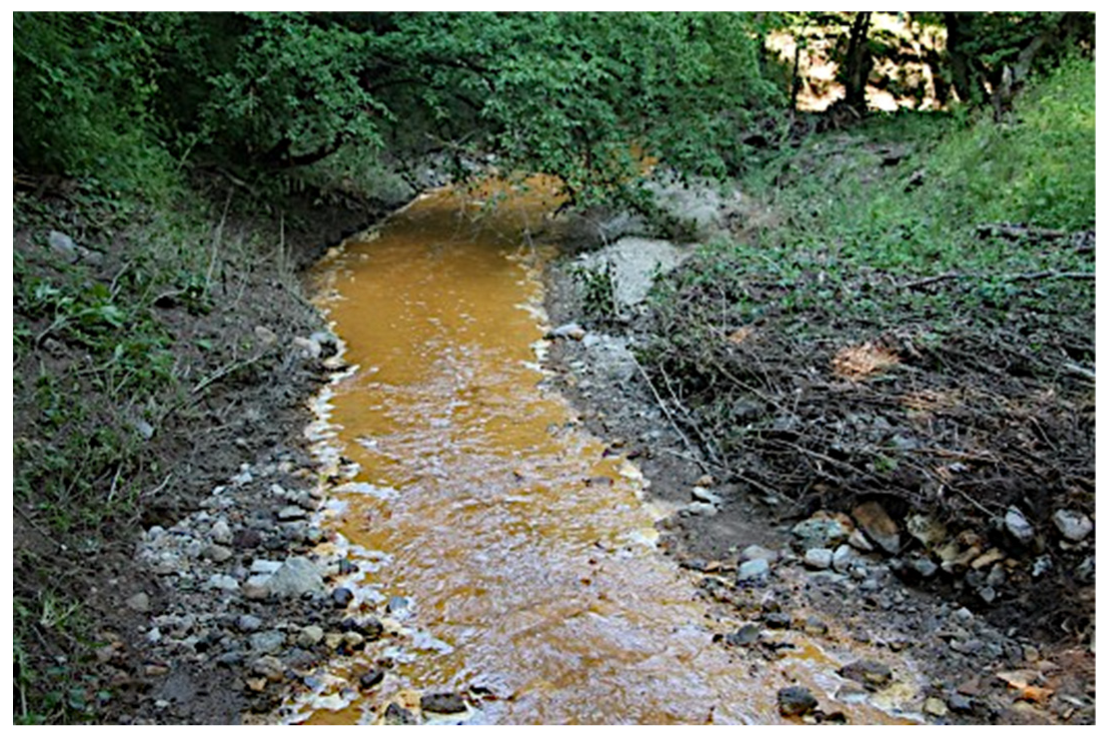

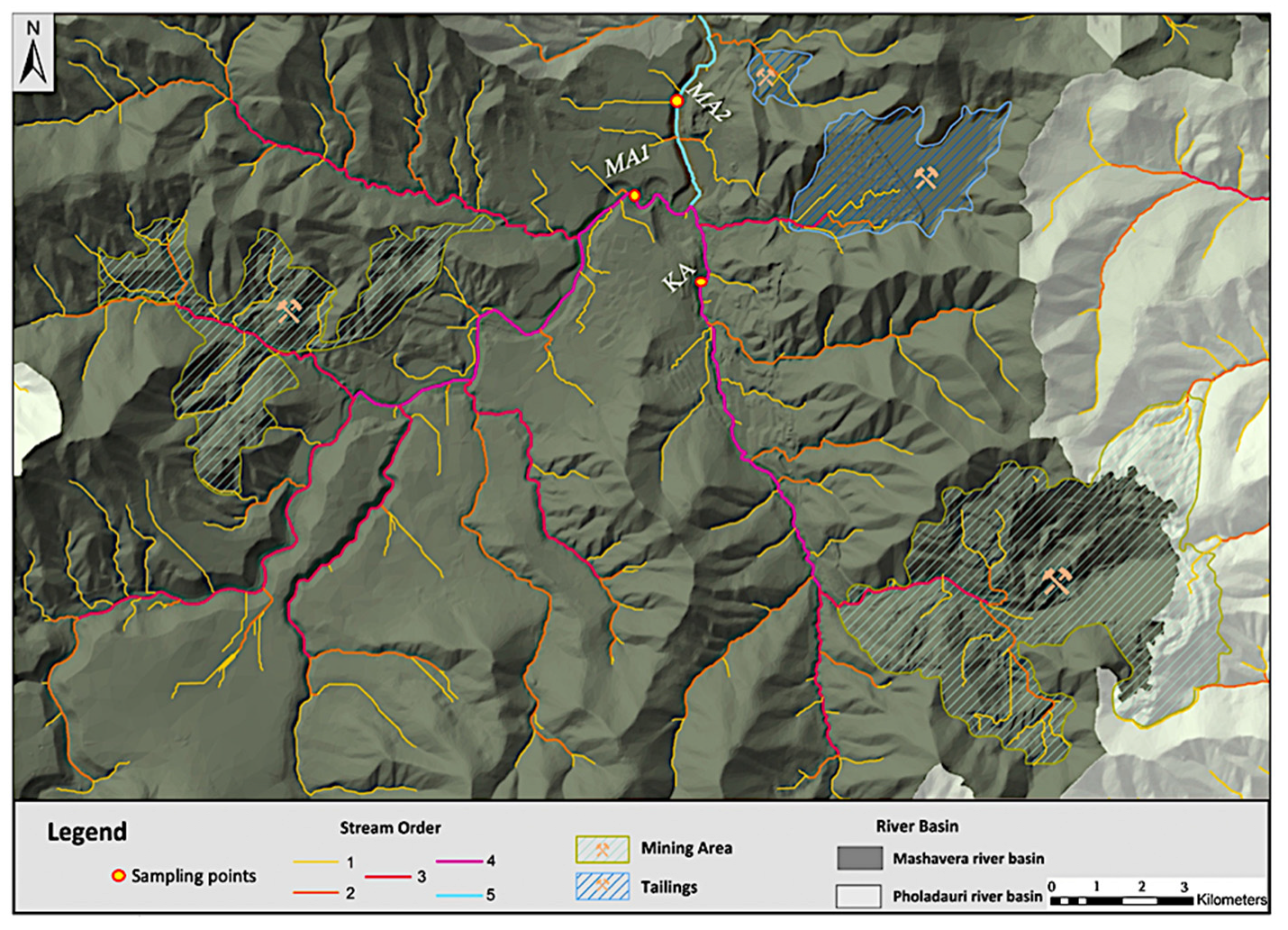
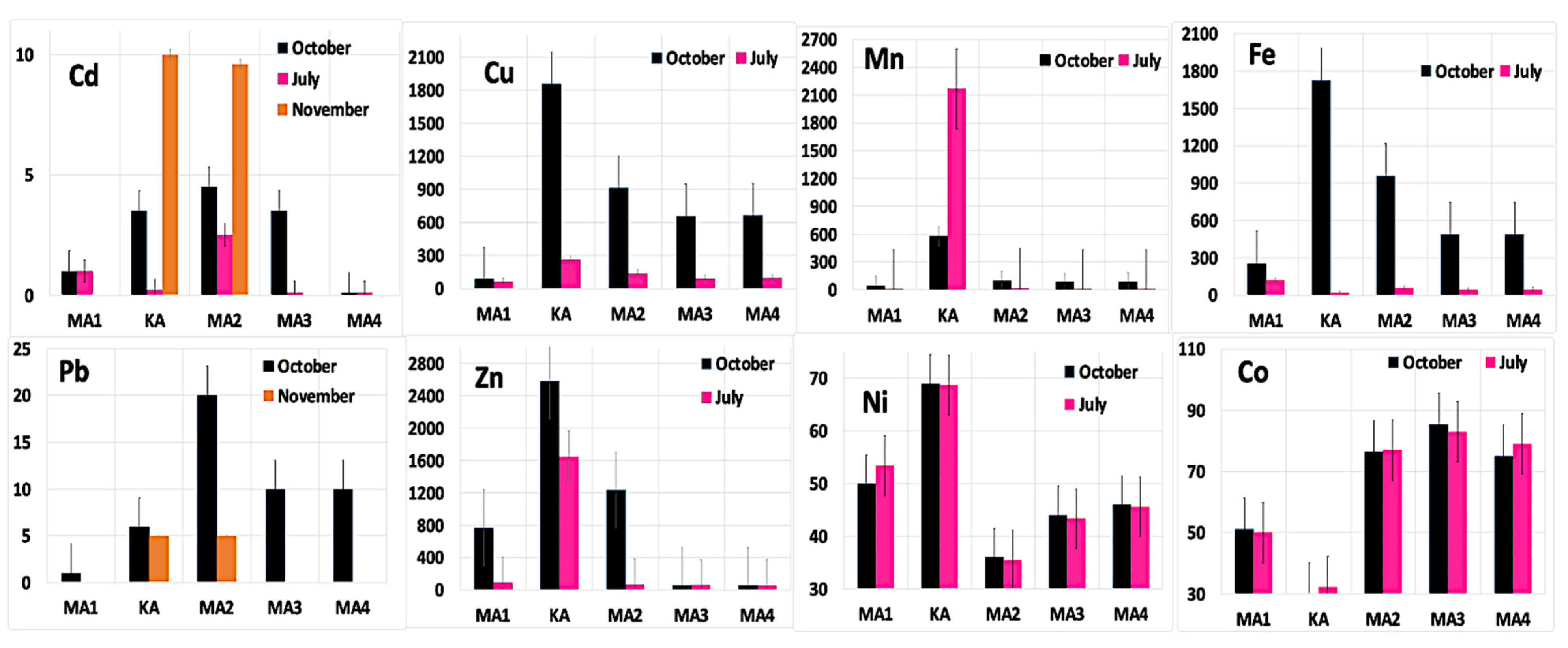
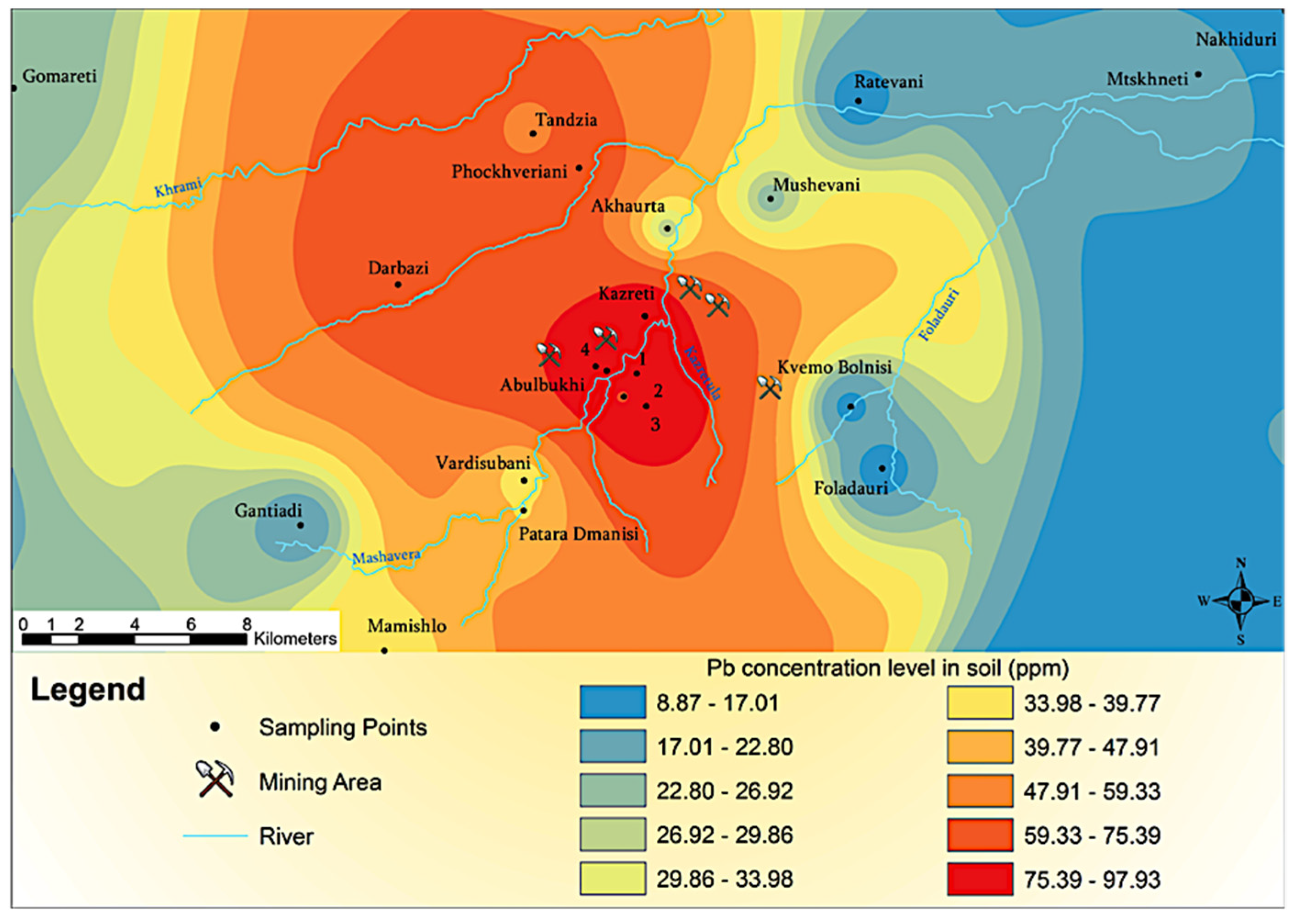
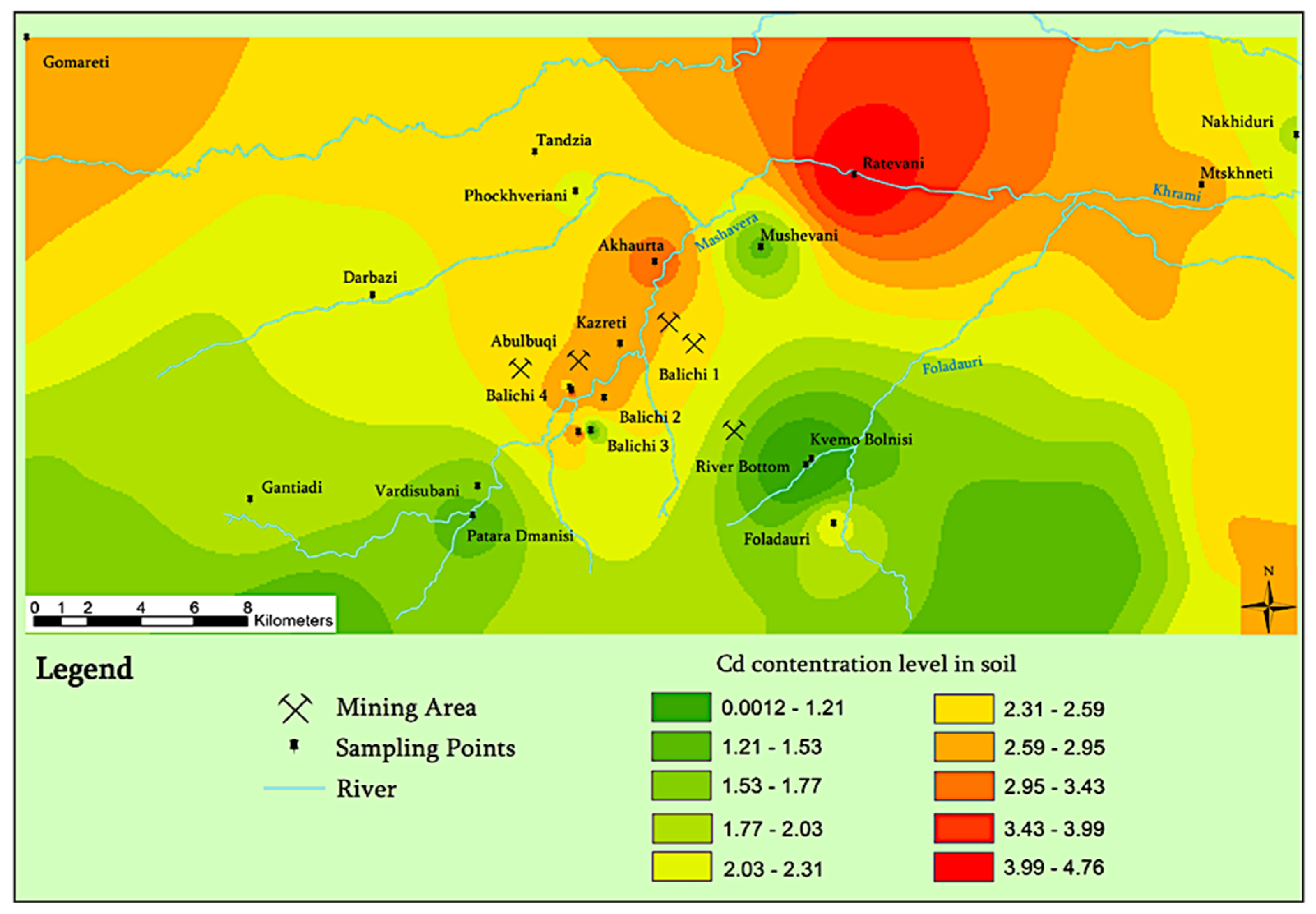
| Shale Values mg/kg | Toxic-Response Factor for Metals | |
|---|---|---|
| Pb | 20 | 5 |
| Mn | 850 | 1 |
| Cd | 0.3 | 30 |
| Zn | 95 | 1 |
| Cu | 45 | 5 |
| Description | Pollution Level | ||
|---|---|---|---|
| Ecological risk factor (ER) | = Contamination factor = Toxic-response factor for metals | ER < 40 = low ecological risk; 40 < ER < 80 = moderate risk; 80 < ER < 160 = considerable risk; 160 < ER < 320 = high risk; ER > 320 = extremely high risk | |
| Potential ecological risk index (RI) | Ecological risk factor; Sum of the elements | RI < 150-minimal risk; 150 ≤ RI < 300-moderate risk; 300 ≤ RI < 600-considerable risk; RI ≥ 600-extremely high risk | |
| Sampling Points | Cd | Mn | Cu | Zn | Pb | ||||||
|---|---|---|---|---|---|---|---|---|---|---|---|
| mg/kg | mg/kg | mg/kg | mg/kg | mg/kg | Dist. to Mine, km 2 | ||||||
| 2017 | 2014 | 2017 | 2014 | 2017 | 2014 | 2017 | 2014 | 2017 | 2014 | ||
| Nakhiduri | 2 | 2.34 | 746.4 | 660 | 153.3 | 361 | 182.4 | 348 | 8.9 | 19.6 | 30 |
| Mtskhneti | 2.6 | 1.44 | 504.3 | 538 | 91.2 | 186 | 122.6 | 233 | 20.4 | 17.2 | 22 |
| Foladauri | 2.2 | 0.14 | 527.2 | 487 | 30 | 53 | 59.7 | 72 | 13.7 | 8.6 | 12 |
| Kvemo Bolnisi | 1.5 | 0.17 | 571.4 | 503 | 24.1 | 32 | 58.8 | 55 | 15.2 | 15.8 | 11 |
| Ratevani | 4.8 | 0.63 | 516.1 | 559 | 145.7 | 149 | 619.7 | 155 | 14 | 20 | 14 |
| Mushevani | 1.5 | 0.24 | 629.8 | 345 | 42.9 | 32 | 72.7 | 56 | 25.5 | 19.7 | 9 |
| Akhaurta | 3.2 | 0.34 | 334.9 | 576 | 25.5 | 41 | 43 | 113 | 28 | 21.7 | 7 |
| Gomareti | 2.9 | 0.11 | 481.4 | 423 | 27.3 | 21 | 40.5 | 34 | 25 | 11 | 22 |
| Gantiadi | 1.9 | 0.16 | 582.2 | 560 | 27.4 | 28 | 44.3 | 84 | 18.4 | 10.4 | 10.5 |
| Vardisubani | 1.7 | 0.17 | 617.5 | 575 | 32.5 | 27 | 58.1 | 96 | 34.5 | 18 | 3 |
| Mamishlo | 1.2 | 0.12 | 466.7 | 546 | 26.1 | 24 | 54.4 | 66 | 35.1 | 9.7 | 10.5 |
| Patara Dmanisi | 1.2 | 0.14 | 494.3 | 642 | 25.8 | 29 | 66.1 | 71 | 39.5 | 10.1 | 5.5 |
| Abulbuqi | 2.2 | 0.28 | 712.2 | 567 | 168.3 | 88 | 628.3 | 120 | 80.7 | 16.6 | 0.1 |
| Tandzia | 2.5 | - | 605.5 | - | 85.2 | - | 59.6 | - | 57.8 | - | 8.5 |
| Darbazi | 2.2 | 0.15 | 550.2 | 420 | 32.3 | 28 | 70.1 | 58 | 62.8 | 13.4 | 6.5 |
| Photskhveriani | 2.2 | - | 616.5 | - | 45 | - | 72.1 | - | 68.5 | - | 7 |
| Kazreti | 2.8 | 0.17 | 600.2 | 462 | 66.3 | 32 | 82.5 | 66 | 91.3 | 16.2 | 3.5 |
| Balichi 1 | 2.9 | 0.18 | 572.1 | 525 | 145.5 | 87 | 93.4 | 78 | 86.9 | 28 | 2 |
| Balichi 2 | 3.1 | 0.20 | 499.1 | 509 | 109.2 | 98 | 233 | 87 | 73.3 | 21 | 2.5 |
| Balichi 3 | 1.3 | 0.22 | 609.3 | 515 | 65.4 | 101 | 120.5 | 94 | 98 | 18.7 | 3 |
| Balichi 4 | 3.3 | 0.3 | 671.5 | 523 | 142.6 | 124 | 300.6 | 89 | 90.1 | 18 | 1 |
| Average | 2.5 | 0.6 | 567.3 | 558.3 | 75.6 | 105 | 154.4 | 134 | 47.7 | 16.6 | |
| Standard Deviation | 1 | 0.73 | 93.4 | 59.9 | 53 | 106 | 171.6 | 91.8 | 30 | 3.8 | |
| Maximum | 4.7 | 2.3 | 746.4 | 660 | 168.3 | 361 | 628.2 | 348 | 98 | 21.7 | |
| Minimum | 1.2 | 0.1 | 334.9 | 462 | 24.1 | 27.5 | 40.5 | 54.8 | 8.9 | 10.1 | |
| Permissable Limits Georgian Guidelines 1 |
Cd 2 |
Mn 500 |
Cu 132 |
Zn 300 |
Pb 32 | ||||||
| WHO 3 | 0.003 | 2 | 0.1 | 0.3 | 0.1 | ||||||
| Sampling Points | Ecological Risk Factor | |||||||||||
|---|---|---|---|---|---|---|---|---|---|---|---|---|
| Cd | Cu | Mn | Zn | Pb | Potential Ecological Risk Index (RI) | |||||||
| 2017 | 2014 | 2017 | 2014 | 2017 | 2014 | 2017 | 2014 | 2017 | 2014 | 2017 | 2014 | |
| Nakhiduri | 202 | 234 | 17 | 40 | 0.9 | 0.8 | 1.9 | 3.7 | 2.2 | 4.9 | 224 | 289 |
| Mtskhneti | 264 | 144 | 10 | 21 | 0.6 | 0.7 | 1.3 | 2.5 | 5.1 | 4.3 | 281 | 183 |
| Ratevani | 476 | 63 | 16 | 17 | 0.6 | 0.7 | 6.5 | 1.6 | 3.5 | 5.0 | 503 | 94 |
| Akaurta | 321 | 34 | 3 | 5 | 0.4 | 0.7 | 0.5 | 1.2 | 7.0 | 5.4 | 331 | 54 |
| Gantiadi | 193 | 16 | 3 | 3 | 0.7 | 0.7 | 0.5 | 0.9 | 4.6 | 2.6 | 202 | 26 |
| Dmanisi | 120 | 14 | 3 | 3 | 0.6 | 0.8 | 0.7 | 0.7 | 9.9 | 2.5 | 134 | 25 |
| Abulbuqi | 224 | 28 | 19 | 10 | 0.8 | 0.7 | 6.6 | 1.3 | 20.2 | 4.1 | 271 | 50 |
| Tandzia | 253 | - | 10 | - | 0.7 | - | 0.6 | - | 14.5 | - | 278 | - |
| Kazreti | 275 | 17 | 7 | 4 | 0.7 | 0.5 | 0.9 | 0.7 | 22.8 | 4.1 | 307 | 33 |
| Balichi | 326 | 22 | 16 | 11 | 0.8 | 0.6 | 3.2 | 1.0 | 22.5 | 4.7 | 368 | 46 |
| Kvemo Bolnisi | - | 17 | 4 | 0.6 | 0.6 | 4.0 | 32 | |||||
| Cu | Pb | Zn | Mn | Fe | Ni | Cd | Co | ||
|---|---|---|---|---|---|---|---|---|---|
| µg/L | µg/L | µg/L | µg/L | µg/L | µg/L | µg/L | µg/L | ||
| Permissible limits 2 | 1000 | 30 | 1000 | 100 | 300 | 130 | 1 | 130 | |
| WHO 3 | 0.017 | 0.065 | 0.20 | 0.20 | 0.50 | 1.40 | 0.01 | 0.05 | |
| Min | Oct | 92.1 | 1.0 | 57.3 | 41.2 | 254.4 | 36.0 | 0.1 | 32.3 |
| July | 58.0 | - 1 | 54.0 | 1.0 | 17.0 | 35.4 | 0.1 | 32.3 | |
| Max | Oct | 1855.3 | 20.0 | 2581.9 | 576.1 | 1723.6 | 69.0 | 4.5 | 85.5 |
| July | 263.0 | - | 1648.0 | 2167.0 | 120.0 | 69.0 | 2.5 | 85.5 | |
| Median | Oct | 667.9 | 10.0 | 768.9 | 84.3 | 487.6 | 46.0 | 3.5 | 76.5 |
| July | 96.0 | - | 65.0 | 1.0 | 45.0 | 46.0 | 0.2 | 77.0 | |
| St.D. | Oct | 643.9 | 7.0 | 1045.2 | 224.6 | 585.4 | 12.3 | 1.9 | 22.4 |
| July | 80.2 | - | 706.7 | 967.2 | 38.6 | 12.7 | 1.0 | 22.5 |
| Acid Mine Drainages | pH | Cu mg/L | Zn mg/L | Cd mg/L |
|---|---|---|---|---|
| Drainage 1 | 2.62 | 537.3 | 5010.0 | 23.65 |
| Drainage 2 | 2.97 | 165.3 | 4460.8 | 2.0 |
| Cu | Mn | Zn | Pb | Cd | |
|---|---|---|---|---|---|
| Correlation | 0.02 | 0.05 | 0.12 | 0.73 | −0.06 |
Publisher’s Note: MDPI stays neutral with regard to jurisdictional claims in published maps and institutional affiliations. |
© 2022 by the authors. Licensee MDPI, Basel, Switzerland. This article is an open access article distributed under the terms and conditions of the Creative Commons Attribution (CC BY) license (https://creativecommons.org/licenses/by/4.0/).
Share and Cite
Avkopashvili, M.; Avkopashvili, G.; Avkopashvili, I.; Asanidze, L.; Matchavariani, L.; Gongadze, A.; Gakhokidze, R. Mining-Related Metal Pollution and Ecological Risk Factors in South-Eastern Georgia. Sustainability 2022, 14, 5621. https://doi.org/10.3390/su14095621
Avkopashvili M, Avkopashvili G, Avkopashvili I, Asanidze L, Matchavariani L, Gongadze A, Gakhokidze R. Mining-Related Metal Pollution and Ecological Risk Factors in South-Eastern Georgia. Sustainability. 2022; 14(9):5621. https://doi.org/10.3390/su14095621
Chicago/Turabian StyleAvkopashvili, Marika, Guranda Avkopashvili, Irakli Avkopashvili, Lasha Asanidze, Lia Matchavariani, Alexander Gongadze, and Ramaz Gakhokidze. 2022. "Mining-Related Metal Pollution and Ecological Risk Factors in South-Eastern Georgia" Sustainability 14, no. 9: 5621. https://doi.org/10.3390/su14095621
APA StyleAvkopashvili, M., Avkopashvili, G., Avkopashvili, I., Asanidze, L., Matchavariani, L., Gongadze, A., & Gakhokidze, R. (2022). Mining-Related Metal Pollution and Ecological Risk Factors in South-Eastern Georgia. Sustainability, 14(9), 5621. https://doi.org/10.3390/su14095621






